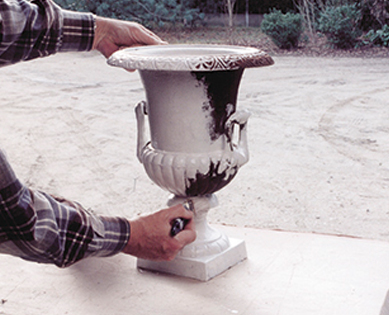Articles » How do I? » A Few More Useful Home Painting Tips
4 Useful Tips To Make Your Painting Projects Easier.
- Make and keep a record of how much paint it takes to cover each room by writing the amount in a log you can keep in your records file or shed.
- Before putting the lid on leftover paint, mark the label at the level of the paint inside, so you can tell at a glance how much is left in the can!
- If you store partially used cans of paint upside down, a skin won't form on the paint's surface. just be sure to shut the lids tightly though to avoid potential mess if opened accidentally!
- Cover chandeliers, light fittings etc with a plastic bag and for safety remove the bulbs first.
What Tools Do I Need To Do The Job?
Basically, you'll need the following: a flat blade 6" screwdriver to open the paint can, scraper, filler knife, a box of filler, sandpaper - coarse, medium and fine, sponges, bucket or empty paint buckets, cleaner, ladder, quality paint roller and tray, roller covers, 2" masking tape, masking paper or plastic film, drop cloth to protect the floor, an old cap, over-all’s (or old clothes / shoes), and maybe a bottle of OOPS! to remove emulsion paint spatters, and finally of course a few clean rags.
HOW To Determine Amount Of Paint Required.
How much paint will you need to paint the walls of a room in your house? Always a good question, especially when you're trying to determine a budget for your decorating job. Firstly, you must determine the size of the area to be painted. Simply multiply the length of each wall by its height to get its square footage either in imperial feet / inches or metric.. whatever you are into.
Add up your totals - remembering to include a calculation for the ceiling separately - and you've got the total square footage you have to cover. Allow for areas occupied by windows and doors. The pro's estimate for same as follows...take out 21 square feet of surface area for an average door and 15 square feet for the average window. Here is a handy website to convert feet to meters etc
Usually you will require one undercoat and one (but sometimes two) top coat(s). Some situations require more paint, for example, weak hiding colours such as yellows, reds etc are notorious and may require several coats to hide properly. TIP: Adding some Floetrol (available on this website) to weak colour paints, undercoats will save you a ton of work in those situations) At the paint shop, check the paint can label(s) for coverage rate info. The estimated coverage is usually listed on every can, if it's not obvious, ask the store assistant to state its coverage and match accordingly to your needs.
How much paint will you need for the outside of your house? You need to multiply the height of each side by its length and add the totals. Gables, the triangular spaces created by the roofline, need a special formula. Multiply the width by the height of the highest point and divide by 2 to get the area of one gable. Do this for each gable and add them all up.
As per above, check the paint can label for coverage rates.
How much is too much?
Always over-estimate the amount of paint you'll need. There's nothing worse than discovering you've run out of paint in the middle of a job! If the surface is rough or textured, you'll need about 20% more paint, because you'll be covering more surface.
Removing paint out of grooves etc.
Here's a great tip for removing old paint from spindle-back chairs or any furniture with tight grooves and spindle edges... Get a string the diameter of the groove, dip it in paint stripper (don't forget to wear your rubber gloves), then use it like dental floss, working it back and forth in the grooves. The paint will be gone and your furniture will be ready for a new finish!




